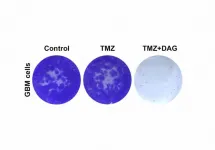(Press-News.org) Glioblastomas are the most common and most aggressive brain tumours. Their survival rate has barely increased over the last 50 years, indicating an urgent need to develop new therapeutic strategies. In a paper published this week in the journal Molecular Cancer Therapeutics, a journal of the American Association for Cancer Research, the team led by Massimo Squatrito, Head of the Seve Ballesteros Foundation Brain Tumour Group at the Spanish National Cancer Research Centre (CNIO), proposes a novel therapeutic strategy based on the combination of temozolomide, the first-line treatment for these patients, and dianhydrogalactitol, a drug that is being tested in clinical trials and is already approved for the treatment of other tumours.
Currently, the main and virtually only treatment for glioblastomas is the combination of radiotherapy and the chemotherapy agent temozolomide, after surgical resection of the tumour mass. Like most chemotherapeutic agents used, temozolomide induces damage to the genetic material of tumour cells, causing them to break down and die. However, in almost half of the patients, such tumours become resistant to the drug and the tumour continues to grow even while undergoing treatment.
"Although the incidence of glioblastoma is not excessively high in adults, they are the most common brain tumours, and there are no effective treatments or markers of response to treatment or of the generation of resistance," says Squatrito.
DNA repair, the basis of resistance
Why do patients with glioblastoma stop responding to temozolomide? Squatrito and his team shed light on this central question last year in a paper published in the journal Nature Communications: some glioblastomas produce genomic rearrangements in the DNA repair gene MGMT, which increases its production and repairs the DNA damage induced by temozolomide so that the tumour manages to grow and evade treatment.
In the paper published now, the researchers studied temozolomide resistance in depth by using glioblastoma cell lines in which several key genes were silenced. The results show that this resistance not only depends on the MGMT gene but that it may also be mediated by failures in the MMR (DNA repair) pathway so that when any of its components are altered, tumour cells accumulate mutations that give them the ability to evade the effects of temozolomide.
Tumours are complex systems that use multiple tools to trick the body into supporting their growth and development. Combination therapies, targeting several components involved in the tumour process, are a revolution that brings hope to many patients. Advances in the understanding of the molecular biology of tumours allow the emergence of new therapies and targeted combinations thereof to fight the tumours and to avoid any type of resistance they may develop.
Combination therapy with dianhydrogalactitol
In the present study, the researchers focused on the drug dianhydrogalactitol, a chemotherapeutic agent that is able to cross the blood-brain barrier and reach the central nervous system, where it induces DNA damage in tumour cells. Dianhydrogalactitol is currently being tested in clinical trials for gliomas and other types of cancer such as ovarian cancer and is already approved in China for the treatment of acute myeloid leukaemia and lung cancer.
The results of this study show that temozolomide and dianhydrogalactitol act synergistically on tumour cells in vitro, resulting in slower growth of these cells compared to when they are treated with each drug individually. The researchers observed similar results in mice with brain tumours, which survived longer when treated simultaneously with temozolomide and dianhydrogalactitol.
Furthermore, the results suggest that, unlike temozolomide, the anticancer effects of dianhydrogalactitol are independent of the MGMT DNA repair gene and the MMR pathway. "Our data show that dianhydrogalactitol could be an effective treatment that circumvents the resistance mechanisms that arise during temozolomide treatment," explains Miguel Jiménez-Alcázar, first author of the paper.
"The results we obtained with this study are of great interest, as they could lead to a substantial improvement in the evolution of these patients," says Squatrito. "It now becomes a matter of urgency to take these finding to clinical practice to see if this combination of drugs increases survival; both drugs are clinically available, which could accelerate the timeline of this new approach," he concludes.
INFORMATION:
This study was funded by the Spanish Ministry of Science and Innovation, the Carlos III Health Institute, the Seve Ballesteros Foundation, the Spanish Association against Cancer (AECC) and the European Molecular Biology Organisation (EMBO).
Reference article: Dianhdrogalactitol overcomes multiple temozolomide resistance mechanisms in glioblastoma. Miguel Jiménez-Alcázar, Álvaro Curiel-García, Paula Nogales, Javier Perales-Patón, Alberto J. Schuhmacher, Marcos Galán-Ganga, Lucía Zhu, Scott W. Lowe, Fátima Al-Shahrour, Massimo Squatrito (Molecular Cancer Therapeutics, 2021). DOI: 10.1158/1535-7163.MCT-20-0319
People who trust television and Facebook to provide them with accurate news about the coronavirus pandemic are less knowledgeable about COVID-19, according to a new study, which assessed people's knowledge of the virus in the earliest stages of the pandemic.
The study, published today in the peer-reviewed journal END ...
Researchers have found common foxgloves brought to the Americas have rapidly evolved to change flower length in the presence of a new pollinator group, hummingbirds. The findings are published in the British Ecological Society's Journal of Ecology.
Researchers from the University of Sussex, Universidad de Los Andes (Colombia) and Universidad de Costa Rica, studying the common foxglove Digitalis purpurea, a bumblebee pollinated species native to Europe, have shown for the first time how rapid physical changes can occur in flowers following a change in environment and the presence of a new pollinator.
The researchers compared foxgloves in the UK, which ...
A recent study indicates that a U.S. ban on the use of tanning beds among minors would prevent thousands of cases of melanoma in adolescents and would save millions of dollars in healthcare costs. The findings are published early online in END ...
Workplace communication often took a back seat this past year, as employees and employers rushed to work remotely, struggled with technology barriers and adjusted to physical distancing. But the pandemic has resulted in valuable lessons for communicating on the job, according to a Baylor University study.
During the onset of COVID-19 -- along with accompanying layoffs and a recession -- "there likely has never been a moment with such demand for ethical listening to employees," said lead author Marlene S. Neill, Ph.D., associate professor of journalism, public relations and new media at Baylor.
"Ethical listening" was defined by one communication ...
April12, 2021 - Gray wolves are among the largest predators to have survived the extinction at the end of the last ice age around11,700 years ago. Today, they can be found roaming Yukon's boreal forest and tundra, with caribou and moose as their main sources of food.
A new study led by the Canadian Museum of Nature shows that wolves may have survived by adapting their diet over thousands of years---from a primary reliance on horses during the Pleistocene, to caribou and moose today. The results are published in the journal Palaeogeography, Palaeoclimatology, Palaeoecology.
The research team, led by museum palaeontologist Dr. Danielle Fraser and student Zoe Landry, analysed evidence preserved in ...
HOUSTON -- Early phase clinical trials conducted by researchers from The University of Texas MD Anderson Cancer Center show promising results for patients with RET fusion-positive cancers, high-grade (HGG) and low-grade glioma (LGG) and ovarian cancer.
The results, presented today at the virtual American Association for Cancer Research (AACR) Annual Meeting 2021, showcase the researchers' ongoing efforts to advance clinical studies and expand potential indications of approved drugs to develop a platform for more effective treatments and to improve patient outcomes.
FDA-approved selpercatinib shows clinical benefits for RET fusion-positive ...
PHILADELPHIA--Giving early-stage pancreatic cancer patients a CD40 immune-stimulating drug helped jumpstart a T cell attack to the notoriously stubborn tumor microenvironment before surgery and other treatments, according to a new study from researchers in the Abramson Cancer Center (ACC) at the University of Pennsylvania. Changing the microenvironment from so-called T cell "poor" to T cell "rich" with a CD40 agonist earlier could help slow eventual progression of the disease and prevent cancer from spreading in more patients.
The data--which included 16 ...
LOS ANGELES -- Early results from a new, pioneering chimeric antigen receptor (CAR) T cell immunotherapy trial led by researchers at the UCLA Jonsson Comprehensive Cancer Center found using a bilateral attack instead of the conventional single-target approach helps minimizes treatment resistance, resulting in long-lasting remission for people with non-Hodgkin's B-cell lymphoma that has come back or has not responded to treatment.
The new approach, which will be presented at the American Association for Cancer Research Annual Meeting during one of the clinical oral plenary sessions ( END ...
New York, NY (April 10, 2021) - A personalized cancer vaccine developed with the help of a Mount Sinai computational platform raised no safety concerns and showed potential benefit in patients with different cancers, including lung and bladder, that have a high risk of recurrence, according to results from an investigator-initiated phase I clinical trial presented during the virtual American Association for Cancer Research (AACR) Annual Meeting 2021, held April 10-15.
"While immunotherapy has revolutionized the treatment of cancer, the vast majority of patients do not experience a significant clinical response with such treatments," said study author Thomas Marron, MD, PhD, Assistant Director for Early Phase and Immunotherapy Trials ...
HOUSTON - Researchers at The University of Texas MD Anderson Cancer Center have discovered that mutant KRAS and p53, the most frequently mutated genes in pancreatic cancer, interact through the CREB1 protein to promote metastasis and tumor growth. Blocking CREB1 in preclinical models reversed these effects and reduced metastases, suggesting an important new therapeutic target for the deadly cancer.
The findings were published today in Cancer Discovery and presented at the virtual American Association for Cancer Research (AACR) Annual Meeting 2021 by Michael Kim, M.D., ...



